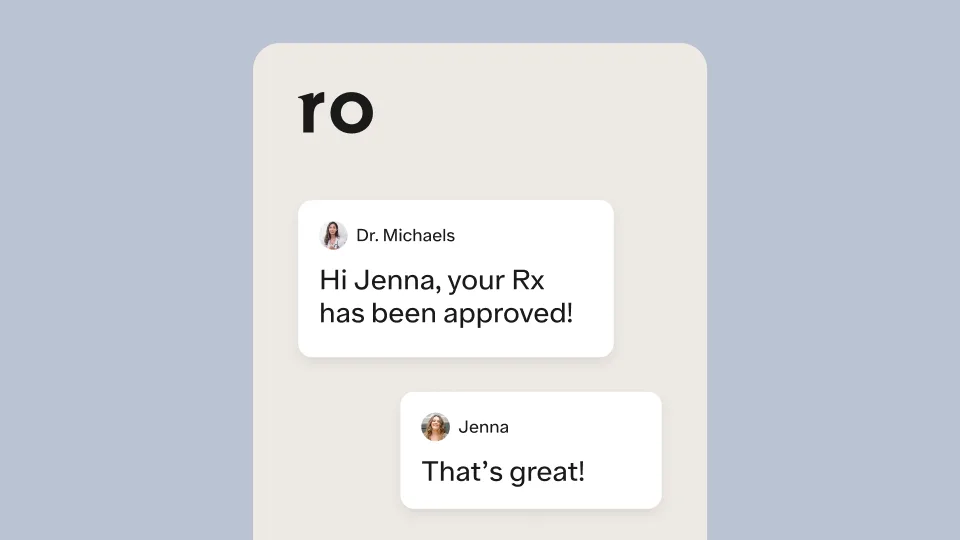Important safety information
What you should know before taking Zepbound.
145
$45
for your first month
(tirzepatide) injection
Lose 20% of your body weight on average in 1 year*. See safety info below.
New FDA-approved medication for weight loss (same active ingredient as Mounjaro)
Targets two hormone receptors (GLP-1 and GIP) to maximize weight loss
Zepbound uses the same active ingredient (tirzepatide) as Mounjaro®. It’s a dual-action GLP-1/GIP-receptor agonist that is approved by the FDA for people with obesity, or overweight plus a weight-related condition, along with diet and exercise changes.
Zepbound and Wegovy are approved by the FDA for weight loss, while Ozempic is approved for the treatment of type 2 diabetes, but can be prescribed off-label for weight loss, if appropriate.
The main difference between these medications is the active ingredient. Ozempic and Wegovy use semaglutide, while Zepbound uses tirzepatide. Tirzepatide is a dual-action GLP-1 and GIP, meaning it works by activating two receptors to curb nausea and regulate your metabolism, helping you feel full faster and longer. In comparison, semaglutide only activates the GLP-1 receptor.
Like other GLP-1 medications, Zepbound comes with the risk of potential side effects. Most people experience these side effects when their dose is increased, and they tend to improve once a steady dose is reached. Some of the most common side effects include:
Nausea
Diarrhea
Vomiting
Constipation
Stomach pains
Upset stomach
Indigestion
Injection-site reactions
Fatigue
Belching and gas
Hair loss
Heartburn
Additionally, if you take oral birth control pills, talk to your healthcare provider before you use Zepbound. Birth control pills may not work as well while using Zepbound. Your healthcare provider may recommend another type of birth control for 4 weeks after you start Zepbound and for 4 weeks after each increase in your dose of Zepbound.
More severe side effects are rarer but possible. Serious side effects include:
Thyroid cancer: Zepbound may cause tumors in the thyroid, including thyroid cancer. Watch for possible symptoms, such as a lump or swelling in the neck, hoarseness, trouble swallowing, or shortness of breath. If you have any of these symptoms, tell your healthcare provider. Do not use Zepbound if you or any of your family have ever had a type of thyroid cancer called medullary thyroid carcinoma (MTC) or if you have Multiple Endocrine Neoplasia syndrome type 2 (MEN 2).
Severe stomach problems
Pancreatitis
Gallbladder disease
Rapid heartbeat
Severe allergy (hypersensitivity)
Low blood sugar
Changes in vision in patients with type 2 diabetes
Kidney disease
Suicidal thoughts or behaviors
Pulmonary aspiration during general anesthesia or deep sedation: . In rare instances, some patients undergoing anesthesia during surgical procedures have had stomach contents enter their lungs, which can cause pneumonia and other problems.
You can report quality complaints and side effects to The Lilly Answers Center (TLAC) at +1(800) 545-5979 to notify Lilly, the manufacturer of your medication. They use side effect information to monitor and sometimes report on drug safety.
These are not all of the possible side effects of Zepbound. For more complete information about Zepbound, including Boxed warning, see full Important Safety Information.
*Patients without diabetes and with BMI ≥30, or BMI ≥27 plus a weight-related condition, lost an average of 20% of their body weight by 1 year in a 72-week trial studying the highest maintenance dose of Zepbound (15 mg), when paired with diet and exercise changes (compared to 3% with diet and exercise alone).
Select your current weight
252lbs
Weight you could lose (lbs):
50lbs
*In a 68- and 72-week clinical trial studying Wegovy (2.4 mg) and Zepbound (15 mg) in patients without diabetes and with BMI ≥30, or BMI ≥27 with a weight-related condition, the average weight loss was 15% and 20%, when paired with diet and exercise changes (compared to 2.4% and 3.1%, respectively, with diet and exercise alone).
Whether you want to check your insurance coverage or prefer to pay cash, we got you. Once you’re a member, we take care of any paperwork and insurance back-and-forth so you don’t have to lift a finger.
Share your health history and weight loss goals with us online to get started. A Ro-affiliated provider will review your answers and get back to you within a few days. Depending on your health review, a provider may order a metabolic lab test before moving forward with treatment.
After reviewing your results, your provider will determine if you’re eligible for medication. If you are, they’ll tailor a program with prescription treatment best suited to your unique biology.
If you’d like to use insurance, a dedicated team will connect with your insurance company to determine your coverage. If you’d prefer to pay cash or if coverage is denied, we’ll help you understand your options across our full GLP-1 suite. Zepbound vials cannot be purchased with insurance, and are cash pay only.
If you’re prescribed Zepbound vials or compounded semaglutide, your medication will typically be shipped to you in 1-4 days. If you're prescribed a GLP-1 pen, you’ll get your prescription from your preferred pharmacy. Medication costs are not included in Body membership pricing.
You’ll have everything you need, including on-demand provider messaging, personalized medication adjustments, and expert guidance on what to expect on your journey – all as part of your membership.
“I started losing weight almost immediately. To me, truly, this has been a game-changer.”
Dr. Pepper Ro Ambassador who inspired the Body Program, after taking GLP-1 medication
“I used to constantly crave food in general. I was always hungry before starting the Body Program.”
Stacie Ro member after taking GLP-1 medication
Meet our expert
From diagnosis to delivery, our healthcare providers are with patients every step of the way.
Ro members taking branded GLP-1 medications were paid for their testimonials.
Yes! If you're interested in starting treatment with Zepbound—whether single-dose pens or vials–the first step is completing an online visit so that a medical provider can determine if treatment is right for you. If you’re prescribed Zepbound single-dose vials, they will be shipped directly to your door via the LillyDirect partner pharmacy.
Like other GLP-1 medications, Zepbound comes with the risk of potential side effects. Most people experience these side effects when their dose is increased, and they tend to improve once a steady dose is reached. Some of the most common side effects include:
Nausea
Diarrhea
Vomiting
Constipation
Stomach pains
Upset stomach
Indigestion
Injection-site reactions
Fatigue
Belching and gas
Hair loss
Heartburn
Additionally, if you take oral birth control pills, talk to your healthcare provider before you use Zepbound. Birth control pills may not work as well while using Zepbound. Your healthcare provider may recommend another type of birth control for 4 weeks after you start Zepbound and for 4 weeks after each increase in your dose of Zepbound.
More severe side effects are rarer but possible. Serious side effects include:
Thyroid cancer: Zepbound may cause tumors in the thyroid, including thyroid cancer. Watch for possible symptoms, such as a lump or swelling in the neck, hoarseness, trouble swallowing, or shortness of breath. If you have any of these symptoms, tell your healthcare provider. Do not use Zepbound if you or any of your family have ever had a type of thyroid cancer called medullary thyroid carcinoma (MTC) or if you have Multiple Endocrine Neoplasia syndrome type 2 (MEN 2).
Severe stomach problems
Pancreatitis
Gallbladder disease
Rapid heartbeat
Severe allergy (hypersensitivity)
Low blood sugar
Changes in vision in patients with type 2 diabetes
Kidney disease
Suicidal thoughts or behaviors
Pulmonary aspiration during general anesthesia or deep sedation: . In rare instances, some patients undergoing anesthesia during surgical procedures have had stomach contents enter their lungs, which can cause pneumonia and other problems.
You can report quality complaints and side effects to The Lilly Answers Center (TLAC) at +1(800) 545-5979 to notify Lilly, the manufacturer of your medication. They use side effect information to monitor and sometimes report on drug safety.
These are not all of the possible side effects of Zepbound. For more complete information about Zepbound, including Boxed warning, see full Important Safety Information.
Both Zepbound pens and vials should be stored in the refrigerator at 36-46º F, but they may be kept between 46-86º F for up to 21 days, if needed. Store unopened pens and vials in their original cartons to protect them from light.
If you store Zepbound pens at room temperature, do not return them to the refrigerator. Do not freeze the pens. The pen contains glass parts, so if you drop the pen on a hard surface, do not use the pen for your injection.
If you store Zepbound vials at room temperature, throw away any unused portion after 21 days. Do not freeze the medication, and do not use it if it has been frozen. Be sure to throw away any opened vial after using it, even if there is medication left in the vial.
This depends whether you’re prescribed Zepbound single-dose pens or vials.
For Zepbound pens, insurance coverage and copays will vary depending on your plan. Our insurance concierge will work with your provider to determine your coverage for GLP-1 medication and, if necessary, submit a prior authorization request for you. If you’re paying cash, Zepbound pens cost about $1,050/mo. If you have commercial insurance, you may be eligible for a discount through the manufacturer. Learn more about the Zepbound savings card here.
The savings card program doesn’t apply to Zepbound single-dose vials, which are available as a cash pay-only offering:
2.5 mg dose – $399/mo
5 mg dose – $549/mo
These medication costs are separate from your Body membership ($45 first month, $145/mo thereafter), which includes our insurance concierge, provider visits, ongoing coaching, and anytime messaging. Learn more about pricing here.
Ro and Ro-affiliated providers are following GLP-1 medication shortages closely so we can support new and existing patients on their weight loss journeys.
Thanks to our new partnership with LillyDirect, you can now access Zepbound single-dose vials, which contain the exact same FDA-approved weight loss formulation as Zepbound pens. These are in stock now and if prescribed, will ship directly to your home.
From the experts at ro
Zepbound mimics two naturally occurring hormones (GLP-1 and GIP) in your body to help you regulate your metabolism. This slows digestion and makes you feel full faster and longer. It also communicates with the part of your brain in charge of hunger to help you regulate how much you eat. On average, patients lost 20% of their body weight in a year using the highest dose of Zepbound when combined with healthy lifestyle changes.
If prescribed, you’ll start on the lowest dose (2.5 mg) for the first four weeks, and then work with your provider to slowly increase your dose every four weeks until you reach a steady dose that works best for you.
Zepbound is a once-weekly injection that comes in a pre-filled, single-dose pen. If prescribed, you’ll receive detailed instructions from your provider on how to inject it in your stomach, arm, or thigh.
In clinical trials, patients lost an average of 20% of their body weight in a year when they combined the highest dose of Zepbound with healthy lifestyle changes.
Zepbound is approved for weight loss in adults who either have a BMI of at least 30 or a BMI of at least 27 with a weight-related condition, like high blood pressure, type 2 diabetes, or cardiovascular disease.
The side effects of Zepbound are similar to Ozempic and Wegovy. However, birth control pills have been shown to be less effective when taking Zepbound. If you’re considering treatment with Zepbound, tell your provider about what contraception you’re taking. For more information about side effects, learn more here: ro.co/safety-info/zepbound
Some health plans cover Zepbound for weight loss, but coverage and copay amounts vary. Plans may also require prior authorization before approving coverage. If you’re interested in paying with insurance, we’ll work with your provider to help you get coverage.










